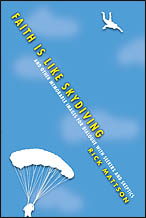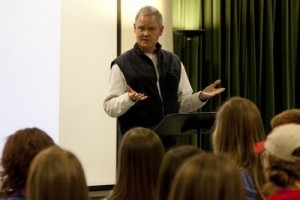
When Faith Is Like Skydiving: And Other Memorable Images for Dialogue with Seekers and Skeptics came in the mail from InterVarsity Press (IVP) I just had to drop my colleague Rick Mattson[1] an email to enable us to learn more about his new publication. Note: As you may remember Rick wrote a resource rich series on Headed to Graduate School which gave testimony to his passion not only for the life of the mind, but also for creatively engaging in dialogue with seekers and skeptics.
Tom: Rick, I am so excited to have received a copy of Faith Is Like Skydiving: And Other Memorable Images for Dialogue with Seekers and Skeptics from IVP. Please share with Emerging Scholars the story behind its publication and little bit about how “faith is like skydiving”.
Rick: Tom, Faith Is Like Skydiving is a reflection of my last five years working as a traveling evangelist/apologist to college campuses around the country—about fifty in all. Often my hosts (usually InterVarsity groups) set up events called “Stump the Chump,” where students can ask me any question they wish about Christianity. Immediately I could see that giving abstract philosophical responses to students’ questions would put them right to sleep. So I began creating images and illustrations that were easier to follow and remember.
A sampling of images includes elephant traps, a hammer, a hole in one, the telephone game, a know-it-all, a doctor, a grand conspiracy, a royal flush, a novelist, a modem. These are all related to issues in apologetics and are designed to be “put into play” quickly and easily in conversation without having to think about it too hard—and without any formal theological training. The book is written mainly for laypeople but I think religious professionals who already know the arguments will gain some quick handles for illustrating their points.
So my overall hope is that the book will help Christians present their case for faith in a manner which is organized, crisp and memorable.
Tom: Please give us a glimpse into how you settled on the format of the publication and how you anticipate it to be best used by individuals, campus fellowships, and local congregations as they engage in dialogue with seekers and skeptics . . . And possibly even explore their own questions?
Rick: Believers are often hesitant to wade into apologetic conversations because they feel intimidated or ill-equipped to handle tough questions and objections. Or if they do enter the fray, they give rambling responses and go off on tangents. But if they’re able to utilize the images in the book, I think they’ll feel a lot more confident—and their interactions with nonChristian friends will be more focused and convincing.
I know it’s made a huge difference for me. I used to ad lib, get lost, say dumb things, philosophize with my head in the clouds . . . well, I still do some of that! But I find myself way more prepared these days as I use the images over and over.
One suggestion I’d have for local congregations or campus fellowships is to memorize a few of the images, then ask each participant to try them out with a nonChristian friend and see what that friend thinks. This approach gets Christians out of the classroom and into real conversations.
Tom: Getting back to the big picture, what three or four points do you desire every reader to take away from Faith Is Like Skydiving?
Rick:
- Learn the images and use them. I’m afraid many people (like me) love to read books and feel spiritually and intellectually stimulated. But if readers take the time to employ the images in real-life conversations, they’ll see the fruit of their efforts.
- Discern your audience. The last three chapters of the book focus on how to get into spiritual conversations in the first place and to discern whether your audience is more modern, postmodern or a combination of both. Then you can tailor your approach accordingly.
- Rely on the Holy Spirit. I do provide a lot of training and encouragement in the book for people to learn the images and be prepared. But I also mention several times that this is not merely a human endeavor. I say: read, study, memorize, prepare hard—then trust in none of this. Give it all to the Lord as you go out and have dialogue with folks created in his image.
Tom: To wrap up, please share with Emerging Scholars an encouragement regarding the value of their role in the Kingdom God and next steps in being “little Christs” on campus.

Rick: Tom, I keep getting back to Daniel, who was exiled in Babylon in the fifth century BC. He learned the customs and ways of the people and became an important messenger for the God of Israel. He was a “little Christ” long before the time of Christ. Those of us who work in the university world have been placed strategically by God to serve as his messengers in a foreign land, just like Daniel. We need to learn to be conversational people, engaging the campus with the gospel.
Tom: Rick, Thank-you for once again sharing your time, gifts, and insights with us! May God continue to bless your dialogical labors on behalf of the Kingdom of God—in particular bringing his salt, light, leaven and life into the relationships to which he has called you to be a “little Christ”. To God be the glory!
Note to those who follow the Emerging Scholars Network: As I recently gave attention to in another interview, genuine dialogue is of great importance to members of the higher ed community. I encourage you to consider reading this book, sharing with a friend, recommending for a discussion group, and/or adding to the resources (where applicable) of your campus fellowship, community outreach, and/or local congregation. For an excerpt from Chapter 1, click here. To God be the glory!
Notes
- Rick Mattson’s call is to strengthen and encourage Christian students and faculty in their faith, and invite seekers and skeptics to consider Christ for their lives. He studied at Bethel Seminary of St. Paul, MN, where he received his masters in the philosophy of religion. Rick’s committed to compassion, reason, and respect in his interactions with both “friend and foe” on campus. He’s also highly committed to InterVarsity’s value of multiethnicity. Rick loves talking with students and faculty about the great questions of life! What could be more fun??? At home, Rick’s a committed family man, serious golfer, and plays e-guitar in the band at his church. . . . And of course he spends a lot of time reading theology and philosophy :).↩
Revised: 4/21/2014, 8:21 am.
Tom enjoys daily conversations regarding living out the Biblical Story with his wife Theresa and their four girls, around the block, at Elizabethtown Brethren in Christ Church (where he teaches adult electives and co-leads a small group), among healthcare professionals as the Northeast Regional Director for the Christian Medical & Dental Associations (CMDA), and in higher ed as a volunteer with the Emerging Scholars Network (ESN). For a number of years, the Christian Medical Society / CMDA at Penn State College of Medicine was the hub of his ministry with CMDA. Note: Tom served with InterVarsity Christian Fellowship / USA for 20+ years, including 6+ years as the Associate Director of ESN. He has written for the ESN blog from its launch in August 2008. He has studied Biology (B.S.), Higher Education (M.A.), Spiritual Direction (Certificate), Spiritual Formation (M.A.R.), Ministry to Emerging Generations (D.Min.). To God be the glory!

Leave a Reply